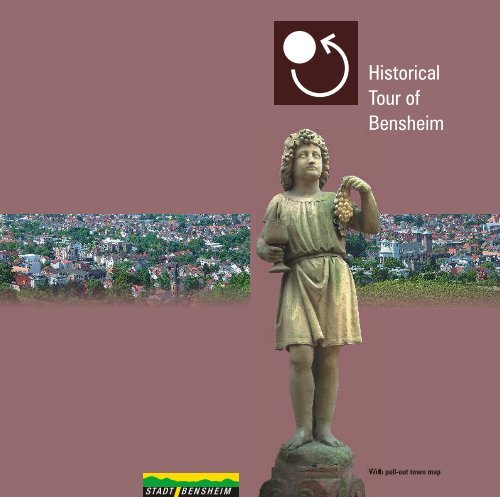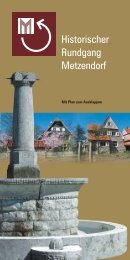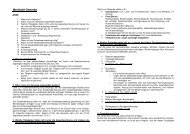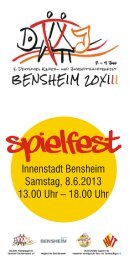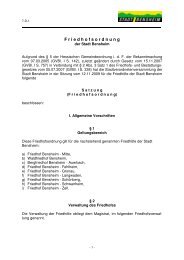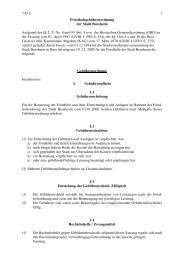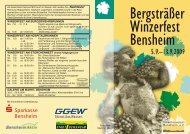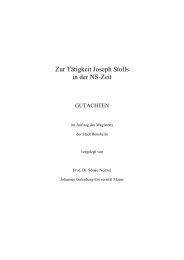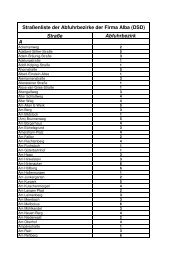Historical Tour of Bensheim
Historical Tour of Bensheim
Historical Tour of Bensheim
Create successful ePaper yourself
Turn your PDF publications into a flip-book with our unique Google optimized e-Paper software.
<strong>Historical</strong><br />
<strong>Tour</strong> <strong>of</strong><br />
<strong>Bensheim</strong><br />
With pull-out town map
Our historical tour <strong>of</strong> <strong>Bensheim</strong><br />
begins at the fountain in the<br />
middle <strong>of</strong> Marktplatz, the town's<br />
market square.<br />
1<br />
Marktbrunnen<br />
The Marktbrunnen (Market Fountain)<br />
dates from 1895. In addition<br />
to the State <strong>of</strong> Hesse’s coat <strong>of</strong><br />
arms, the fountain is decorated<br />
not only with allegorical representations<br />
<strong>of</strong> justice, agriculture<br />
and artisanry, but also depictions<br />
<strong>of</strong> children and the four seasons.<br />
Four wrought waterspouts emerge<br />
from lion masks. As a dragonslaying<br />
knight, St. George, the<br />
January, but now takes place on<br />
Shrove Monday. Market rights<br />
were granted in 956.<br />
2<br />
Marktplatz 22<br />
Built in 1615, this timber-framed<br />
corner house with a two-storey<br />
bay and half-hipped ro<strong>of</strong> is the<br />
former Zur Armbrust inn. A<br />
wooden plaque with two coats<br />
<strong>of</strong> arms also bears an inscription<br />
about the builders that says: “He<br />
who trusts in God has built well,<br />
Wilhelm Kurtz and Katarina, his<br />
housewife.” The husband’s coat<br />
<strong>of</strong> arms shows two crossed golden<br />
bars against a red field and a<br />
town and church patron, keeps a<br />
stube (Office), the southern tim-<br />
2 watchful eye over the regular far-<br />
4 Marktplatz 16-18 ber-framed wall above the older, 3<br />
mers’ markets and four seasonal<br />
fairs from his vantage point<br />
at the top <strong>of</strong> the fountain.<br />
St. George’s<br />
Market in April and St.<br />
Martin’s Market in<br />
November were first<br />
documented in 1504.<br />
They were joined in<br />
1619 by St. Giles<br />
Market in early<br />
September and in<br />
1829 by St. Sebastian’s<br />
Market,<br />
St. George<br />
on the<br />
Marktbrunnen<br />
which was originally<br />
held on 20th<br />
golden linden leaf, which also<br />
cross the bars; his wife’s presents<br />
two crossed silver hooks<br />
and two silver faces against a<br />
field <strong>of</strong> blue. The house’s now<br />
exposed timber framing was hidden<br />
from view until well into the<br />
post-war period.<br />
3<br />
Marktplatz 21<br />
The renaissance timber framework<br />
<strong>of</strong> this three-storey house<br />
appears relatively unaltered. It<br />
was built around 1600, probably<br />
by Alderman Werner Duchscherer.<br />
The property was bought in<br />
1891 by master shoemaker<br />
Christoph Mitterie for the shop<br />
he had already opened two years<br />
before.<br />
A ro<strong>of</strong>ed-over wooden figure<br />
situated between the first-floor<br />
windows portrays the Franciscan<br />
preacher Anthony <strong>of</strong> Padua with<br />
the Infant Jesus. Born in Lisbon<br />
in 1195 and christened as Fernandez,<br />
the church teacher was<br />
canonized by Pope Gregory IX in<br />
1232 and, among others, is the<br />
patron saint <strong>of</strong> lovers, marriage,<br />
women and children, the poor<br />
and travellers as well as bakers<br />
and miners.<br />
The ensemble <strong>of</strong> three identical<br />
timber-framed houses built in<br />
1682 “as an adornment <strong>of</strong> the<br />
Market Square” dominate its<br />
southern side. The buildings<br />
were commissioned by town<br />
drummer and limer Cornelius<br />
Straub, ribbon weaver Hans<br />
Schellhorn and barber Friedrich<br />
Bock.<br />
The two supports <strong>of</strong> the outer<br />
house corners are decorated<br />
with a carved and turned staff<br />
and spiral ornaments over both<br />
timber-framed storeys.<br />
5<br />
Museum der Stadt<br />
<strong>Bensheim</strong><br />
With one storey<br />
facing north<br />
and two storeys<br />
facing<br />
south, the<br />
side-gabled<br />
building<br />
that now<br />
houses<br />
<strong>Bensheim</strong>’s<br />
municipal<br />
museum is probably<br />
built on remains<br />
<strong>of</strong> part <strong>of</strong> the former Lorsch<br />
Abbey. According to the date inscribed<br />
in the interior <strong>of</strong> the Amts-<br />
massive basement probably<br />
stems from the year 1590. The<br />
Louis XVI-style folding door in<br />
the Baroque entry portal is particularly<br />
striking. The museum has<br />
sections covering pre- and early<br />
history, the skilled trades, agriculture,<br />
winegrowing and housekeeping<br />
as well as an updated<br />
town history section. It has been<br />
housed in the building since<br />
1960.<br />
The museum is open on Thursdays<br />
and Fridays from 3 to 6<br />
p.m. and on Saturdays and Sundays<br />
from 12 to 6 p.m.<br />
Frontier<br />
sign at the<br />
municipal<br />
museum
Older<br />
decorative<br />
element<br />
on the<br />
façade<br />
Katholische Pfarr-<br />
6 central section and two side<br />
<strong>of</strong> Anne-Frank-Halle, the sports<br />
kirche St.Georg<br />
towers were erected between<br />
1949 and 1953. Two spolia, ele-<br />
hall <strong>of</strong> the adjacent Liebfrauenschule,<br />
on the site <strong>of</strong> <strong>Bensheim</strong>’s<br />
A basilica in honour <strong>of</strong> ments taken from the original last synagogue, which dated<br />
St. Michael was pro- medieval church, namely a lion from 1892. Unveiled in May<br />
bably erected at the figure and a lamb with halo and 2000, the memorial depicts both<br />
old town’s highest flag, can be found on the new the intact synagogue and the<br />
elevation some façade, which is strongly influen- ruins left by the Nazi devastation<br />
time during the<br />
early Middle Ages.<br />
ced by Romanesque forms.<br />
<strong>of</strong> 10 November 1938.<br />
The later construction<br />
<strong>of</strong> a Gothic<br />
7 Roter Turm<br />
9 Walderdorffer H<strong>of</strong><br />
church dedicated to The Roter Turm (Red Tower) was In Obergasse you will find Wal-<br />
St. George on the site <strong>of</strong> an older built in around 1300 as part <strong>of</strong> derdorffer H<strong>of</strong>, southern Hesse’s<br />
Romanesque tower probably the town wall and originally had oldest timber-framed building pre-<br />
occurred at the time <strong>of</strong> the a steep hip ro<strong>of</strong>, which was<br />
served in such a complete state.<br />
Crusades. By the end <strong>of</strong> the 18th<br />
century, Pfarrkirche St. Georg<br />
replaced in 1833 by a historici- Tree-ring dating shows that the<br />
(St. George’s Parish Church) was zing embattled parapet with cor-<br />
century. The northern side <strong>of</strong> the<br />
4 described as “dilapidated, not bel arches. Two corner consoles side-gabled building was erected eastern wing that joins it proba- 5<br />
very spacious and unsightly”. In<br />
1826, the main structure, but not<br />
the tower, was demolished and<br />
a neo-classical three-aisled<br />
pseudo-basilica was built to a<br />
design by Georg Salomon Moller,<br />
the court architect <strong>of</strong> the Grand<br />
Duchy <strong>of</strong> Hesse. The new church<br />
was consecrated in 1830.<br />
The building was completely gutted<br />
following a bombing raid on<br />
26 March 1945 and the old<br />
tower had to be pulled down.<br />
New eastern towers on each<br />
side <strong>of</strong> the choir and an entirely<br />
new westwork with a risalit-like<br />
on the southern side probably<br />
stem from the same period. They<br />
depict the heads <strong>of</strong> a bearded<br />
man and a woman, over which<br />
you can also see a waterspout in<br />
the shape <strong>of</strong> a wolf’s head. The<br />
original <strong>of</strong> the replica plaque on<br />
the eastern side originated from<br />
the Auerbach Tower Gate, which<br />
was demolished in 1836.<br />
8<br />
Synagogen-<br />
Mahnmal<br />
The Synagogen-Mahnmal (Synagogue<br />
Memorial) stands in front<br />
in 1395, although it is likely that<br />
it had a steep thatched ro<strong>of</strong> until<br />
the 17th century. A beautiful<br />
piece <strong>of</strong> ironwork above the<br />
entrance shows the Walderdorff<br />
coat <strong>of</strong> arms: a gold-coroneted<br />
silver lion with a red head and<br />
mane on a black shield, the crest<br />
shows spread black wings, each<br />
<strong>of</strong> which repeat the heraldic figure,<br />
and the mantling is silvery<br />
black. A remnant <strong>of</strong> the old town<br />
wall forms the northern boundary<br />
<strong>of</strong> the property.<br />
10<br />
Dalberger H<strong>of</strong><br />
The oldest part <strong>of</strong> Dalberger H<strong>of</strong><br />
is probably the tower, which was<br />
built in 1587, but now has a cambered<br />
ro<strong>of</strong> dating from the 18th<br />
bly consists <strong>of</strong> part <strong>of</strong> the former<br />
town wall. The municipality <strong>of</strong><br />
<strong>Bensheim</strong> has owned this noble<br />
property since 1866. The<br />
wrought iron window baskets on<br />
the ground floor were originally<br />
located in front <strong>of</strong> the upper floor<br />
windows on the northern side,<br />
the open arcade on the southern<br />
side <strong>of</strong> the upper floor was only<br />
cleared again during refurbishment<br />
in 1998.
6<br />
Hohenecker H<strong>of</strong><br />
The building was erected in 1756<br />
by the dean <strong>of</strong> Mainz Cathedral,<br />
Johann Franz Baron von Hoheneck,<br />
after whom it was named.<br />
Following the demolition <strong>of</strong> the<br />
town wall and the laying out <strong>of</strong> a<br />
park, the western side was dominated<br />
by the neo-Gothic red<br />
brick façade with stepped gable,<br />
small embattled tower, balcony<br />
and loggia with balustrades. The<br />
eastern side <strong>of</strong> the Baroque timber-framed<br />
building has arched<br />
hatch openings in the pediment<br />
and would still appear to be original.<br />
A shell-shaped cartouche<br />
with the Hoheneck coat <strong>of</strong> arms<br />
and an inscription is situated above<br />
the three-centred arch <strong>of</strong> the<br />
entrance. A neo-Gothic portal<br />
with merlons, small corner<br />
towers and a lattice gate were<br />
built on the street side. At the<br />
top <strong>of</strong> the arch over the metal<br />
gate there is a keystone bearing<br />
a rose symbol and inscribed<br />
with the year 1533; it probably<br />
stems from an earlier<br />
structure. Above this you can<br />
see a Baroque statue <strong>of</strong> John<br />
<strong>of</strong> Nepomuk.<br />
Wambolter H<strong>of</strong><br />
11 12<br />
southwards, but was pulled<br />
Portal at<br />
Hohenecker H<strong>of</strong><br />
Wambolter H<strong>of</strong> was built by<br />
Franz Philipp Caspar Freiherr<br />
Wambolt von Umstadt in 1733<br />
as a two-storey two-wing<br />
building. The main portal is set<br />
asymmetrically in the eastern<br />
façade and bears the Wambolt-<br />
Kesselstadt alliance coat <strong>of</strong> arms<br />
and the inscription <strong>of</strong> the year<br />
1743, which refers to the marriage<br />
<strong>of</strong> Franz Philipp Caspar and<br />
Maria Charlotte Freiin von Kesselstadt.<br />
Like the main wing, the<br />
west wing with timber-framed<br />
upper floor and gable also carries<br />
a mansard hip ro<strong>of</strong> with dormers.<br />
13<br />
Rinnentorturm<br />
Probably built at the beginning <strong>of</strong><br />
the 14th century, the Rinnentorturm,<br />
a gate tower, is now all<br />
that remains <strong>of</strong> larger fortifications<br />
including a gateway that<br />
used to span the road<br />
down in 1885. Originally the Lauter<br />
flowed through this gateway,<br />
but today the river, which is<br />
known as the Winkelbach from<br />
this point, has been redirected to<br />
the north. The adjacent square<br />
has been named after <strong>Bensheim</strong>’s<br />
Hungarian twin town,<br />
Mohács.<br />
14<br />
Marienhaus<br />
The Zum schwarzen Bären inn<br />
was built here by Philip Hornig in<br />
1597. The superb timber-framed<br />
building with hipped gable ro<strong>of</strong><br />
has conspicuous side-gable protrusions<br />
that imply that the building<br />
once had open arcades. In<br />
1679 it became home <strong>of</strong> the<br />
<strong>Bensheim</strong> Wine Cellar after its<br />
separation from Heppenheim.<br />
From 1783 Philipp Jakob Feldh<strong>of</strong>en<br />
ran an inn called Zur goldenen<br />
Rose. The building is also<br />
described as Haus Bendheim,<br />
after the Jewish merchant Heinrich<br />
Bendheim II, who acquired it<br />
in 1862. During the Third Reich<br />
the property was transferred to<br />
the Hospital and has been known<br />
as Marienhaus since that time.<br />
15<br />
Katholische<br />
Hospitalkirche<br />
St. Joseph<br />
Aesthetically,<br />
Hospitalkirche<br />
St. Joseph<br />
(St. Joseph’s<br />
Hospital Church)<br />
dominates the<br />
whole lower<br />
pedestrian area.<br />
The quadrangular<br />
raw hall with<br />
ridged ro<strong>of</strong> and<br />
red sandstone<br />
masonry dates<br />
Windows <strong>of</strong><br />
St. Joseph’s Church<br />
back to the 14th century and<br />
probably stands on the site <strong>of</strong> a<br />
church that Giselhelm the Frank<br />
donated to Lorsch Abbey in 817<br />
with a collection <strong>of</strong> relics and an<br />
estate. The choir with tracery<br />
windows was added in around<br />
1500.<br />
The nave probably continued to<br />
be used for caring for the poor,<br />
elderly and sick after the end <strong>of</strong><br />
the Middle Ages.<br />
7
16 wooden bridge and numerous the Bürgerwehrbrunnen. This is<br />
The location <strong>of</strong> the Hospitalbrunnen<br />
(Hospital Fountain) was first<br />
recorded in 1526. Refurbishment<br />
in 1711 saw the addition <strong>of</strong> a<br />
column with sphere. Later, in<br />
1842/43, the fountain was completely<br />
rebuilt a few metres north<br />
<strong>of</strong> its original location. Since<br />
1935 two putti have<br />
crowned the fountain<br />
column, which possibly<br />
still dates from the 18th<br />
century.<br />
buildings. As a result <strong>of</strong> a solemn<br />
pledge, Johann Georg and Maria<br />
Margaretha Ernsperger, a married<br />
couple who managed to escape<br />
with their lives, endowed two<br />
statues for the stone bridge that<br />
was built one year later and still<br />
stands today. In 1740 the monument<br />
to the Prague Vicar-General<br />
St. John <strong>of</strong> Nepomuk was erected<br />
on the western side <strong>of</strong> the<br />
bridge. In 1747 the eastern statue<br />
followed in the shape <strong>of</strong> the<br />
Catholic theologian and Jesuit<br />
where the Mainz Cathedral Chapter,<br />
the administrative authority<br />
<strong>of</strong> the diocese, maintained an outpost.<br />
Originally a solid twostorey<br />
structure with dressed<br />
corner pilaster-strips, fascia,<br />
Baroque panels and a stepped<br />
hip ro<strong>of</strong>, an additional floor was<br />
added and a mansard ro<strong>of</strong> built<br />
in 1874.<br />
Following secularization, the building<br />
housed the <strong>of</strong>fice <strong>of</strong> the bailiff<br />
as well as the state and district<br />
council. In 1868 the building<br />
Francisco de Jaso y Azpilicueta, was purchased by <strong>Bensheim</strong> to<br />
better known as St. Francis<br />
house the high school and later<br />
Xavier. The three cited dates are the elementary school. The sta-<br />
At the same time, the <strong>Bensheim</strong> encoded as chrono-<br />
tue <strong>of</strong> St. Aloysius, patron saint 20 Bürgerwehr-<br />
8 metalsmith Christian Schütz grams in the ins-<br />
<strong>of</strong> schoolchildren and students,<br />
9<br />
added the waterspouts embellished<br />
with leaves and grapes.<br />
Although there were plans to<br />
rechristen the fountain Weinbrunnen<br />
(Wine Fountain), it continued<br />
to be known by its old<br />
name.<br />
17<br />
Hospitalbrunnen<br />
Waterspout on the Hospitalbrunnen<br />
Mittelbrücke<br />
The Mittelbrücke (Middle Bridge)<br />
crosses the Lauter, linking the<br />
old town centre with the quarter<br />
that was once outside its walls.<br />
In 1732 a violent storm and devastating<br />
flood destroyed the old<br />
criptions.<br />
18<br />
Domkapitelfaktorei<br />
Built in 1732, the<br />
rather imposing<br />
former Domkapitelfaktorei<br />
(Agency <strong>of</strong> the<br />
Mainz episcopal<br />
chapter) dominates<br />
the square<br />
surrounding<br />
Statue<br />
on the<br />
Mittelbrücke<br />
in a shell-shaped niche in the<br />
gable above the portal, probably<br />
also dates from this period.<br />
In the early 20th century the building<br />
was used by the town<br />
museum and the local police and<br />
its cellars by the municipal<br />
vineyard. After the Second World<br />
War it was home to government<br />
<strong>of</strong>fices, clubs, an adult education<br />
centre and the municipal library.<br />
Today you will find the <strong>Tour</strong>ist<br />
Information Office and the municipal<br />
Citizens’ Information Office<br />
here.<br />
19<br />
„Stolperstein”<br />
Mahnmal<br />
The Stolperstein Mahnmal<br />
(Stumbling Block Memorial)<br />
looks back to the Nazi period,<br />
when Jewish citizens and dissidents<br />
were deported from this<br />
spot in front <strong>of</strong> the police station.<br />
The memorial was created in<br />
1995 by Mannheim-based artist<br />
Rainer Negrelli. It represents the<br />
tip <strong>of</strong> a huge swastika and symbolizes<br />
either the disappearance<br />
or re-emergence <strong>of</strong> Nazi ideas.<br />
brunnen<br />
The Bürgerwehrbrunnen (Militia<br />
Fountain) was erected in 1934<br />
following the refurbishment <strong>of</strong><br />
the surrounding square on the<br />
initiative <strong>of</strong> technical instructor,<br />
principal and council clerk<br />
Joseph Stoll, who founded <strong>Bensheim</strong>’s<br />
historical militia.<br />
The classicistic column by<br />
Darmstadt court sculptor Philipp<br />
Johann Scholl decorated the<br />
Marktbrunnen until 1895.
10<br />
21 Haus Jost<br />
23<br />
The Jost corner house was built<br />
at the beginning <strong>of</strong> the 16th century<br />
and it still has various late<br />
medieval timber elements in the<br />
form <strong>of</strong> “head” and “foot” supports,<br />
while the andiron-shaped<br />
braces and “foot beams” on the<br />
first floor stem from a later modification.<br />
One important feature is<br />
the carved 18th century entrance<br />
facing the Bürgerwehrbrunnen.<br />
22<br />
Haus Fleck<br />
Haus Fleck, a relatively narrow<br />
three-storey building with striking<br />
latticework and a steep ro<strong>of</strong>,<br />
was documented as a butcher’s<br />
stall in 1504. It had open stalls<br />
for butchers who <strong>of</strong>fered their<br />
wares for sale under municipal<br />
price control. In 1714 the municipal<br />
authority leased the building<br />
to Italian merchants. Joseph<br />
Ferrari then bought the property<br />
in 1748. In 1757 he had the<br />
statue <strong>of</strong> St. Joseph added to the<br />
northwestern corner <strong>of</strong> the<br />
building. Later owners included<br />
Ferrari’s son Adolph and the<br />
merchants Kless and Fleck. In<br />
1923 the timber framework was<br />
returned to its original uncovered<br />
state in the course <strong>of</strong> building<br />
modifications.<br />
Fraa-vun-Bensem-<br />
Brunnen<br />
The Fraa-vun-Bensem-Brunnen<br />
(Woman from <strong>Bensheim</strong> Fountain)<br />
is centrally located in a<br />
small park next to the former<br />
town mill. Built in 1935, it<br />
consists <strong>of</strong> a square basin made<br />
<strong>of</strong> reddish brown clinker bricks<br />
with a corresponding column,<br />
crowned by the legendary figure<br />
who gives the fountain its name.<br />
According to legend, towards<br />
the end <strong>of</strong> the Thirty Years’ War,<br />
when <strong>Bensheim</strong> was occupied<br />
by Swedish and French troops,<br />
an old woman led Bavarian<br />
soldiers through the millrace into<br />
the town “from behind”.<br />
The Bavarians<br />
proceeded to kill the<br />
Swedes and French,<br />
thereby “freeing”<br />
<strong>Bensheim</strong>.<br />
Statue at<br />
Haus Fleck<br />
<strong>Historical</strong> Facts<br />
20 April 765 First documentary<br />
record <strong>of</strong> <strong>Bensheim</strong> in the<br />
Codex Laureshamensis, the <strong>of</strong>ficial<br />
register <strong>of</strong> Lorsch Abbey.<br />
773 Charlemagne places the<br />
Heppenheim Marches, to<br />
which <strong>Bensheim</strong> belongs,<br />
under the administration <strong>of</strong> the<br />
Imperial Abbey<br />
<strong>of</strong> Lorsch.<br />
5 March 956<br />
Emperor Otto I<br />
grants <strong>Bensheim</strong><br />
market<br />
rights.<br />
1220 The Imperial<br />
Abbey <strong>of</strong> Lorsch is<br />
made a sovereign principality<br />
subject directly<br />
and solely to the Holy<br />
Roman Emperor.<br />
1232 The Imperial<br />
Abbey <strong>of</strong><br />
Lorsch – and with<br />
it <strong>Bensheim</strong> – comes<br />
into the possession <strong>of</strong><br />
the Archbishop <strong>of</strong><br />
Mainz.<br />
1301 Large parts <strong>of</strong><br />
<strong>Bensheim</strong> are destroyed<br />
by King Albrecht I.<br />
16 April 1320 <strong>Bensheim</strong>'s<br />
town rights are confirmed<br />
by Elector and Archbishop <strong>of</strong><br />
Mainz Peter von Aspelt. Town<br />
rights had probably already<br />
been granted in the mid-13th<br />
century.<br />
1342 The Hospital is documented<br />
for the first time on a<br />
gravestone at the Hospitalkirche.<br />
1461 <strong>Bensheim</strong> is pledged to<br />
Electoral Palatinate as part <strong>of</strong><br />
the District <strong>of</strong> Starkenburg<br />
during a feud between two<br />
rival archbishops <strong>of</strong> Mainz.<br />
1504 <strong>Bensheim</strong> is subjected to<br />
an unsuccessful 11-day siege<br />
by Landgrave William II <strong>of</strong> Hesse<br />
during a feud with Bavaria.<br />
1619 Count Palatine Frederick<br />
V approves St. Giles Market on<br />
1 September.<br />
1644 On 20 November <strong>Bensheim</strong><br />
is captured by French and<br />
Swedish troops. Bavarian units<br />
use their cunning to enter<br />
the old town through the<br />
millrace and defeat the<br />
Swedes and French. This<br />
later gives rise to the<br />
legend <strong>of</strong> the Fraa vun<br />
Bensem.<br />
1650 The Bergstrasse<br />
is redeemed<br />
by the Archbishop<br />
<strong>of</strong> Mainz in the<br />
Bergstrasse Settlement.<br />
1802/1803 The<br />
District <strong>of</strong> Starkenburgbecomes<br />
part <strong>of</strong> the<br />
Landgraviate <strong>of</strong><br />
Hesse-<br />
Darmstadt<br />
following<br />
the secularization<br />
<strong>of</strong> the<br />
Electorate <strong>of</strong> Mainz<br />
by the Principal Conclusion <strong>of</strong><br />
the Extraordinary Imperial Delegation.<br />
1806 The Landgraviate <strong>of</strong> Hesse-Darmstadt<br />
becomes a Grand<br />
Duchy following its accession to<br />
the Confederation <strong>of</strong> the Rhine.<br />
1939 Incorporation <strong>of</strong> Auerbach,<br />
Schönberg and Zell.<br />
1971 Incorporation <strong>of</strong> Fehlheim,<br />
Gronau, Hochstädten,<br />
Langwaden, Schwanheim and<br />
Wilmshausen.
Bahnh<strong>of</strong><br />
Schwanheimer<br />
Straße<br />
Wormser-<br />
Straße<br />
100 m<br />
WC<br />
Amersham-<br />
Platz<br />
Gartenstraße<br />
P<br />
Rodensteinstraße<br />
Bahnh<strong>of</strong>straße<br />
Neckarstraße<br />
Am Rinnentor<br />
Neckarstraße<br />
Mathildenstraße<br />
Ritzhaubstraße<br />
Hospitalstraße<br />
Neckarstraße<br />
Neugasse<br />
P<br />
Rodensteinstraße<br />
Aulgässchen<br />
Fehlheimer Straße<br />
Promenadenstraße<br />
P P<br />
Promenadenstraße<br />
Aulstraße<br />
Mathildenstraße<br />
Beauner<br />
Platz<br />
Wilhelmstraße<br />
Park-Theater<br />
Dalberger<br />
10<br />
H<strong>of</strong><br />
P<br />
Hohenecker<br />
H<strong>of</strong> 11<br />
Rinnentor<br />
13 Mohácsturm<br />
Platz<br />
Kellereigasse<br />
Hospital<br />
Bürgerhaus<br />
Bahnh<strong>of</strong>straße<br />
Grabengässchen<br />
Gerbergasse<br />
14<br />
Am Bürgerhaus<br />
Kath. 15<br />
Hospitalkirche<br />
Am<br />
Ritterplatz<br />
Dalberger Gasse<br />
16<br />
Schuhgasse<br />
Hauptstraße<br />
Schlinkengasse<br />
Mittel- 17<br />
brücke<br />
WC<br />
Nibelungenstraße<br />
Klostergasse<br />
Marktplatz<br />
P<br />
Walderdorffer<br />
H<strong>of</strong> 9<br />
2 3<br />
1<br />
WC<br />
Obergasse<br />
Kapuzinergässchen<br />
4<br />
WC<br />
5<br />
Museum<br />
21 22 „Fraa<br />
Stolper-<br />
23 vun<br />
steinBürger- Bensem”<br />
19 20 wehrbrunnen<br />
Wambolter 18<br />
H<strong>of</strong> 12 Faktorei<br />
Am<br />
Wambolter<br />
H<strong>of</strong><br />
Am Rinnentor<br />
Straße<br />
Mittelgasse<br />
Darmstädter<br />
Heinrich-von-<br />
Gagern-Platz<br />
Hospitalbrunnen<br />
Hauptstraße<br />
Lauter<br />
Hasengasse<br />
Hauptstraße<br />
Liesengasse<br />
Rodensteinstraße<br />
Stadtpark<br />
hist. Stadtmauer<br />
Lammertsgasse<br />
Mittlere Hasengasse<br />
Hasengasse<br />
An der Stadtmühle<br />
Erbacher Straße<br />
Augartenstraße<br />
Kleine<br />
Obere Hasengasse<br />
Klosterkirche<br />
Raabgasse<br />
Hasengasse<br />
Zeller Straße<br />
Kalkgasse<br />
Grieselstraße<br />
Klodzko-<br />
Platz<br />
P<br />
6<br />
P<br />
Platanenallee<br />
Synagogen-<br />
Mahnmal<br />
8 Bendheim-<br />
Platz<br />
Roter<br />
Turm<br />
7<br />
Kath. Kirche<br />
St. Georg<br />
Lammertsgasse<br />
Sandstraße<br />
Nibelungenstraße<br />
Obere Grieselstraße<br />
P
www.bär-und-krieger.de<br />
Find out<br />
more<br />
about<br />
<strong>Bensheim</strong>:<br />
Selected Reading<br />
Rudolf Köster: Die Namen der<br />
<strong>Bensheim</strong>er Strassen, Wege,<br />
Plätze und Passagen von A–Z<br />
erläutert. Museumsverein <strong>Bensheim</strong><br />
1996, ISBN 3-931960-05-6<br />
Griesbach-Maisant, Dieter:<br />
Kulturdenkmäler in Hessen Kreis<br />
Bergstrasse I. Die Städte <strong>Bensheim</strong>,<br />
Heppenheim und Zwingenberg.<br />
Landesamt für Denkmalpflege<br />
Wiesbaden 2004.<br />
ISBN 978-3-8062-1905-0<br />
Maass, Rainer and Berg,<br />
Manfred (Publisher): <strong>Bensheim</strong><br />
Spuren der Geschichte. Edition<br />
Diesbach Weinheim 2006<br />
ISBN 3-936468-31-1<br />
www.bensheim.de<br />
<strong>Bensheim</strong> <strong>Tour</strong>ist Information<br />
Office Hauptstr. 39 (Alte Faktorei)<br />
Tel +49 (0)6251 58263-14<br />
Fax +49 (0)6251 58263-31<br />
Email touristinfo@bensheim.de<br />
<strong>Bensheim</strong> Town Museum<br />
Marktplatz 13<br />
Opening Hours:<br />
Thu + Fri 3 – 6 p.m.<br />
Sat + Sun 12 – 6 p.m.<br />
Tel +49 (0)6251 58478-65<br />
Fax +49 (0)6251 58478-66<br />
Email museum@bensheim.de<br />
Verkehrsverein <strong>Bensheim</strong> e.V.<br />
(<strong>Tour</strong>ism Association)<br />
Kirchbergstrasse 18<br />
Tel +49 (0)6251 58263-50<br />
Fax +49 (0)6251 58263-31<br />
www.verkehrsverein-bensheim.de<br />
Email info@verkehrsvereinbensheim.de<br />
Festivals: Bergsträsser Weinfrühling<br />
with "Wine Meeting” (late<br />
April/early May), <strong>Bensheim</strong>er Bürgerfest<br />
(early June), Bergsträsser<br />
Winzerfest (early September) with<br />
large firework display<br />
Impressum<br />
Publisher: Magistrat der Stadt<br />
<strong>Bensheim</strong> – <strong>Tour</strong>ist-Info 2009<br />
Text: Manfred Berg<br />
Translator: Derek Whitfield<br />
Design and photographs:<br />
bär und krieger


